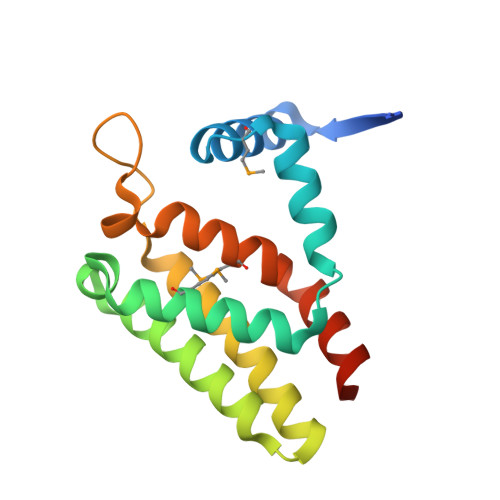An anti-CRISPR that pulls apart a CRISPR-Cas complex.
Trost, C.N., Yang, J., Garcia, B., Hidalgo-Reyes, Y., Fung, B.C.M., Wang, J., Lu, W.T., Maxwell, K.L., Wang, Y., Davidson, A.R.(2024) Nature 632: 375-382
- PubMed: 38961300
- DOI: https://doi.org/10.1038/s41586-024-07642-3
- Primary Citation of Related Structures:
8JDH, 8JDI - PubMed Abstract:
In biological systems, the activities of macromolecular complexes must sometimes be turned off. Thus, a wide variety of protein inhibitors has evolved for this purpose. These inhibitors function through diverse mechanisms, including steric blocking of crucial interactions, enzymatic modification of key residues or substrates, and perturbation of post-translational modifications 1 . Anti-CRISPRs-proteins that block the activity of CRISPR-Cas systems-are one of the largest groups of inhibitors described, with more than 90 families that function through diverse mechanisms 2-4 . Here, we characterize the anti-CRISPR AcrIF25, and we show that it inhibits the type I-F CRISPR-Cas system by pulling apart the fully assembled effector complex. AcrIF25 binds to the predominant CRISPR RNA-binding components of this complex, comprising six Cas7 subunits, and strips them from the RNA. Structural and biochemical studies indicate that AcrIF25 removes one Cas7 subunit at a time, starting at one end of the complex. Notably, this feat is achieved with no apparent enzymatic activity. To our knowledge, AcrIF25 is the first example of a protein that disassembles a large and stable macromolecular complex in the absence of an external energy source. As such, AcrIF25 establishes a paradigm for macromolecular complex inhibitors that may be used for biotechnological applications.
Organizational Affiliation:
Department of Molecular Genetics, University of Toronto, Toronto, Ontario, Canada.















